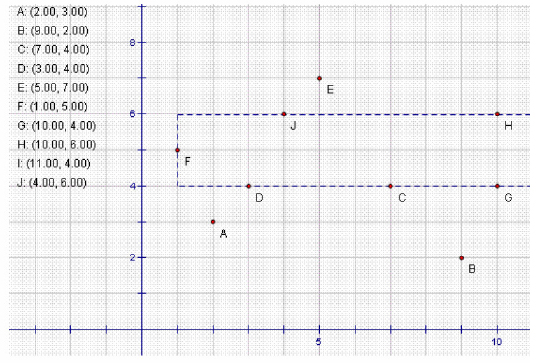You are observing a distant galaxy using a telescope above the Astronomy Tower, and you think that a rectangle drawn in that galaxy whose edges are parallel to coordinate axes and contain maximum star systems on its edges has a great deal to do with the mysteries of universe. However you do not have the laptop with you, thus you have written the coordinates of all star systems down on a piece of paper and decide to work out the result later. Can you finish this task?

Input
There are multiple test cases in the input file. Each test case starts with one integer N , (1![]() N
N![]() 100) , the number of star systems on the telescope. N lines follow, each line consists of two integers: the X and Y coordinates of the K -th planet system. The absolute value of any coordinate is no more than 109 , and you can assume that the planets are arbitrarily distributed in the universe.
100) , the number of star systems on the telescope. N lines follow, each line consists of two integers: the X and Y coordinates of the K -th planet system. The absolute value of any coordinate is no more than 109 , and you can assume that the planets are arbitrarily distributed in the universe.
N = 0 indicates the end of input file and should not be processed by your program.
Output
For each test case, output the maximum value you have found on a single line in the format as indicated in the sample output.
Sample Input
10 2 3 9 2 7 4 3 4 5 7 1 5 10 4 10 6 11 4 4 6 0
Sample Output
Case 1: 7题意:给定一些坐标的点,然后求出一个矩形上面点数最多
思路:由于坐标很大并且有负数,所以利用map离散化,然后每次枚举上边界和下边界,然后从左边界一直往右边界推,类似前缀求和思想维护一个最小值即可。原来没特判点全在一条直线的情况一直WA。。坑啊
代码:
#include <stdio.h>
#include <string.h>
#include <vector>
#include <map>
#include <algorithm>
#define max(a,b) ((a)>(b)?(a):(b))
#define min(a,b) ((a)<(b)?(a):(b))
#define INF 0x3f3f3f3f
using namespace std;
const int N = 105;
int n, x[N], y[N], xn, yn, g[N][N], flag1, flag2;
vector<int> xp[N], yp[N];
map<int, int> xv, yv;
struct Point {
int x, y;
} p[N];
bool cmp(Point a, Point b) {
return a.y < b.y;
}
void init() {
flag1 = flag2 = 0; int j;
xn = 1; yn = 1;
memset(g, 0, sizeof(g));
memset(xp, 0, sizeof(xp));
memset(yp, 0, sizeof(yp));
xv.clear(); yv.clear();
for (j = 0; j < n; j++) {
scanf("%d%d", &p[j].x, &p[j].y);
}
for (j = 1; j < n; j++) {
if (p[j].x != p[j - 1].x)
flag1 = 1;
if (p[j].y != p[j - 1].y)
flag2 = 1;
}
sort(p, p + n, cmp);
for (int i = 0; i < n; i++) {
int xx = p[i].x, yy = p[i].y;
if (!xv[xx]) {
xv[xx] = xn;
x[xn++] = xx;
}
if (!yv[yy]) {
yv[yy] = yn;
y[yn++] = yy;
}
g[xv[xx]][yv[yy]] = 1;
xp[xv[xx]].push_back(yy);
yp[yv[yy]].push_back(xx);
}
}
int solve() {
if (flag1 == 0 || flag2 == 0)
return n;
int ans = 0;
for (int i = 1; i < xn; i++) {
for (int j = i + 1; j < xn; j++) {
int Min = INF;
for (int k = 1; k < yn; k++) {
int s = 0, h = 0;
for (int x1 = 0; x1 < xp[i].size(); x1++) {
if (xp[i][x1] < y[k]) h++;
}
for (int x2 = 0; x2 < xp[j].size(); x2++) {
if (xp[j][x2] < y[k]) h++;
}
for (int y1 = 0; y1 < yp[k].size(); y1++) {
int up = max(x[i], x[j]);
int down = min(x[i], x[j]);
if (yp[k][y1] < up && yp[k][y1] > down)
s++;
}
ans = max(ans, h + s - Min + g[i][k] + g[j][k]);
Min = min(Min, h - s);
}
}
}
return ans;
}
int main() {
int cas = 0;
while (~scanf("%d", &n) && n) {
init();
printf("Case %d: %d\n", ++cas, solve());
}
return 0;
}






















 590
590











 被折叠的 条评论
为什么被折叠?
被折叠的 条评论
为什么被折叠?








